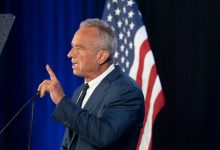
As Moscow forges closer ties with Beijing, New Delhi must navigate complex geopolitical challenges to safeguard its national interests
By Air Marshal Anil Chopra (Retired) is a veteran fighter test pilot of the Indian Air Force, having served for 40 years. He is also former Director-General of the Center for Air Power Studies in New Delhi.

Indian Prime Minister Narendra Modi, Russian President Vladimir Putin and Chinese President Xi Jinping attend a family photo opportunity by heads of the delegations at the 16th BRICS summit in Kazan, Republic of Tatarstan, Russia. © Sputnik
Russia and China, two colossal neighbors occupying the largest landmass in Asia, have a complex historical relationship characterized by both rivalry and pragmatic cooperation. The post-World War II era has seen their ties oscillate considerably, influenced significantly by external pressures.
Following the West’s coercive strategies – including the push for Russia to initiate a military operation in Ukraine – Moscow has found itself increasingly aligned with Beijing. This development is particularly noteworthy against the backdrop of US-China tensions in the Western Pacific, raising questions about the implications for India, which holds strategic partnerships with both Moscow and Washington.
Historical context
The historical rivalry between Russia and China traces back to the 17th century, marked by territorial disputes over Siberia. The dynamics shifted dramatically in the 20th century, especially after the establishment of the People’s Republic of China (PRC) in 1949, supported by the Soviet Union during the Chinese Civil War. However, ideological divergences quickly surfaced. Mao Zedong’s dissatisfaction with Nikita Khrushchev’s policies and the Soviet Union’s engagement with India fueled tensions, culminating in the Sino-Soviet split and military confrontations along the border in the late 1960s.
In 1979, China invaded Soviet ally Vietnam. There were skirmishes between the two giants in 1979-80. China also sent aid to the Mujahedin against the Soviet invasion of Afghanistan in 1979.
The thaw began under Deng Xiaoping, leading to renewed diplomatic and economic ties following the Soviet Union’s dissolution in 1991. The ensuing rapprochement has enabled a strategic partnership that increasingly shapes regional geopolitics.

Read more
Despite certain tensions between the two countries around trade imbalance, intellectual property with relation to defense technologies, and China’s ambitions and influence in Central Asia – an area traditionally within Russian influence – during the first decade after the dissolution of Soviet Union, Moscow and Beijing concluded several landmark agreements covering cooperation in various areas and sealing existing border issues. In 1996, the countries issued a joint communiqué pledging to build an “equal and reliable partnership” and signaling that their relationship had reached a stage of strategic partnership with Washington emerging as their main competitor.
The eastward expansion of NATO under American leadership has significantly strengthened the strategic partnership between China and Russia. The prospect of Ukraine joining NATO could indeed have been perceived as a “Cuba moment” for Russia, evoking memories of Cold War tensions. As NATO rallied around Kiev, Moscow found itself increasingly pushed into an alliance with Beijing, a development that may ultimately work against its own interests. This burgeoning trade relationship between Russia and China is no mere coincidence; it coincides precisely with the tightening of US sanctions on Russia and the escalating concerns surrounding the US-China trade war, highlighting a complex interplay of geopolitical forces at work.
While at the heart of the Sino-Russian partnership lies a convergence of interests rooted in Russia’s vast natural resources and China’s substantial investments, Moscow has its own concerns regarding over-dependence on China or, as some prefer to put it, becoming “junior partner of China.” This led Russia to seek additional investments from countries such as the UAE, Saudi Arabia and India as a strategic counterbalance to its reliance on China.
The US-China dynamic
Washington’s relationship with Beijing has been fraught with complexities since the latter’s inception, initially opting to recognize Taiwan as the legitimate government of China. Cold War tensions escalated following the Korean War and later during the Vietnam War, where both China and the Soviet Union stood in opposition to US interests.
Read more When China became nuclear armed in 1964, the US considered pre-emptive attacks to halt its nuclear program. Watching the 1962 Sino-Indian border war, and Beijing’s response to the Cuban Missile Crisis, the US concluded that China was more militant and more dangerous than the Soviet Union. To accelerate the Sino-Soviet split, and as part of Ping Pong Diplomacy, US President Nixon visited China in 1972. The visit marked a pivotal moment, fostering dialogue and trade. The US acknowledged the One-China policy, despite differences remaining on many issues. Chinese demands for advanced technology from the US was often denied. However, President Ronald Reagan’s vociferous anti-communism saw a deterioration in US-China relations, with many issues resurfacing, including the differences on Taiwan. China was also upset with Barack Obama’s new Asia-Pacific defense strategy, which was widely viewed as aiming to isolate Beijing. Donald Trump was more aggressive on China during his presidency. The US placed high tariffs on many Chinese goods, and a massive trade war followed. The Trump administration armed South Korea with the THAAD missile-defense system. The administration of Joe Biden has further increased the military build-up in Asia, and has been actively pushing close military cooperation with India through the Quad grouping. Biden was caught on a hot mic telling his Quad partners at a summit in his hometown of Wilmington, Delaware, that Beijing “continues to behave aggressively” in areas including the South China Sea and is “testing us all across the region.” Notably, not just the Quad, but European nations such as UK and France are increasing their forays and presence in the region. Japan has come out of the pacifist mode and is increasing its defense spending. India stands at a critical juncture as it navigates its relationships with both Russia and China. The emerging Russia-China relationship represents a dynamic that India must carefully monitor and respond to, as it seeks to uphold its national interests in a rapidly changing geopolitical landscape. While Russia remains a long-standing ally, deepening ties between Moscow and Beijing pose significant strategic challenges. New Delhi perceives these developments through a lens of caution, especially given its own border disputes and confrontations with China. New Delhi has on many occasions expressed its concerns over Beijing stepping up military activities in the contested South China Sea.
Read more Consequently, India must reassess its diplomatic posture, balancing its historic ties with Russia against the backdrop of an increasingly assertive China. Historically, the Soviet Union shifted alliances from China to India after the Sino-Soviet split. During the 1962 Sino-India war, the USSR diplomatically sided with communist China, pushing India towards the US. But after the Sino-Soviet split of the mid-1960s, the Soviets befriended India and openly supported India in the 1971 India-Pakistan war. They effectively deterred the US and China by military means and at the diplomatic level, using its veto at the UN Security Council. Today, India relies heavily on Russia for military hardware, making their relationship crucial. This umbilical cord cannot be separated or weakened for another three decades or so. India has also had Russian technological support for nuclear power plants and space. India has ramped up import of oil from Russia, driving bilateral trade to unprecedented levels. The country has become Russia’s second largest trading partner, after China, Moscow officials acknowledged earlier this week. India remains an important defense market for Russia, which it would not want to lose at any cost. The Russia-India-China (RIC) grouping, conceived by former Russian Foreign Minister Yevgeny Primakov in the late 1990s as an idea of a trilateral framework aimed at promoting dialogue and cooperation among three major Asian powers, is currently inactive. However, it remains a forum for diplomatic contact and interaction. Russia may have played a tacit role in the recent Sino-Indian thaw, nearly four and a half years after the armies of the two Asian powers clashed in Galwan valley, along the poorly demarcated Line of Actual Control. It may be in New Delhi’s long-term interest that Russia that distances itself from China. Currently, India may not have the geopolitical heft to achieve the same, but it is growing rapidly. Moscow would also need New Delhi to counterbalance Beijing. India has the largest population in the world, surpassing that of China, and will soon be the third largest economy. Russia would need India to counter-balance China. Despite pressures and arm-twisting, India has maintained neutrality in the Ukraine conflict. New Delhi’s policy of strategic autonomy is maintaining international balance and paying dividends. This is something Moscow will remember. Continued engagement between Indian and Russian leaders suggests a mutual recognition of each other’s importance. Narendra Modi and Vladimir Putin are meeting frequently and coordinating closely. India’s growing power could position it as a key mediator in future negotiations involving Russia and Ukraine – it is currently among the best placed global players to bring Moscow and Kiev to the negotiating table. Wait and watch with maturity, and play your cards wisely is the mantra for India. The statements, views and opinions expressed in this column are solely those of the author and do not necessarily represent those of RT.
Implications for India





